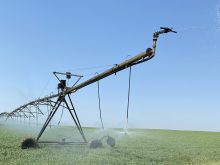Snow accumulation along the eastern slopes of the Rocky Mountains appears to bode well for runoff and the coming irrigation season, Alberta Environment reports.
The mountain runoff forecast as of Feb. 7, posted by the department, indicates above average levels in the Oldman River Basin near Lethbridge and Brocket, as well as in the Bow River Basin at Banff, Calgary, Minnewanka and Spray River.
Above average mountain runoff is also predicted for the Red Deer River at Dickson Dam and in the North Saskatchewan River at Edmonton. Much above average runoff is predicted for the Bighorn Reservoir, also in the North Saskatchewan River basin.
Read Also

Manitoba community projects get support from HyLife
HyLife Fun Days 2025 donated $35,000 each to recreation and housing projects in Killarney, Steinach and Neepawa earlier this fall.
The Milk River basin at Western Crossing is predicted to have above average runoff, while Milk River itself is predicted to be average.
St. Mary River and Waterton River, in the Oldman River basin, are also listed with an average forecast, as are the Kananaskis River, Elbow River and Highwood River in the Bow River basin.
The forecasts assume normal precipitation over the rest of the winter and through the summer, Alberta Environment said in its runoff report.
As for mountain snowpack, it varies considerably. In the Oldman basin, snowpack is below normal at Allison Pass and above normal at Lee Creek.
In the Bow River basin, snowpack is generally above average, as are levels in the North Saskatchewan River basin.
Mountain snowpack is an important water source, the department said, and at this time of year it is at about two-thirds of the seasonal total. In southern Alberta, accumulations tend to peak in mid-April to early May.
Environment Canada, in its long lead precipitation outlook issued Jan. 31, said Alberta temperatures are forecast to be below normal for February through April except along the southern portion of the eastern slopes, where temperatures will be in the normal range.
“Precipitation is forecast to be above normal for the February through April 2018 period, except for northeastern Alberta, which is forecast to be normal,” Environment Canada said.
Asked what would be the ideal scenario for the province’s coming irrigation season, Alberta Environment listed the following:
- Waterton Reservoir at 1,185 metres (within 0.5 metres of full supply level) by the first week of June
- St. Mary Reservoir at 1,103.3 metres (within 0.5 – 0.7 metres of full supply) by the first week of June
- Oldman Reservoir at full supply (1,118.6 metres) by July 1
- Internal storage within the St. Mary River Irrigation District at above average volumes to meet summer demand going into July
The filling of those reservoirs will depend to a large degree on the level of mountain runoff this spring.
















